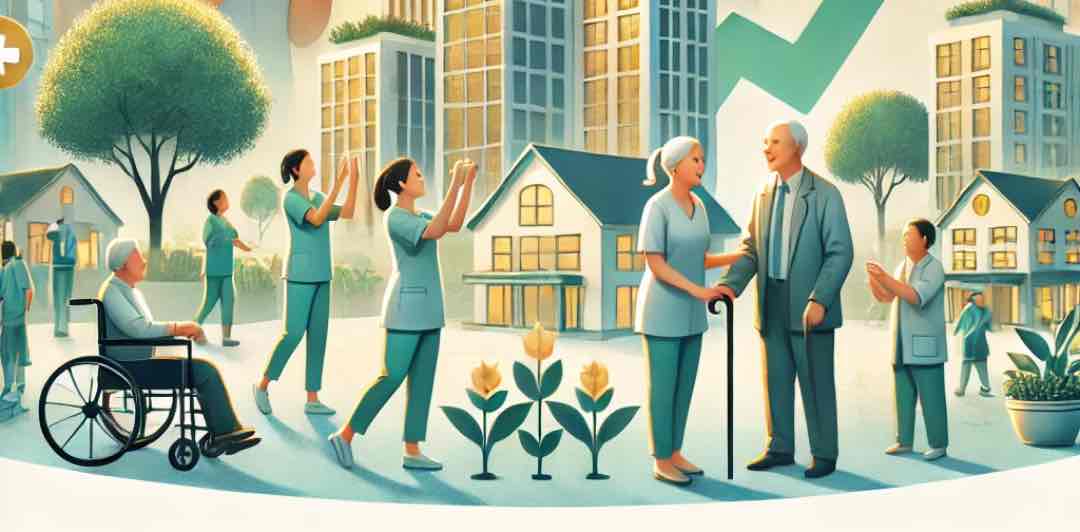
Today, let’s talk about the topic of elderly care that is relevant to everyone. Just recently on December 30, the CPC Central Committee and the State Council issued the “Opinions on Deepening the Reform and Development of Elderly Care Services”. I have said in previous classes that the joint document issued by the CPC Central Committee and the State Council is the highest level of documents, proving that this document is very important.
Based on the content of this document, I will explain three questions to you today: Why does the country want to reform elderly care services? What opportunities and wealth changes are there in this process?
Why is elderly care expected to become a new economic growth point?
Let’s get straight to the point.
The fourth part of the document that has the most to do with today’s topic is: Building a tripartite coordination mechanism for the development of the elderly care service industry. It contains two meanings: First, elderly care services are a career led by the government; second, elderly care services are also a new type of industry that requires market operation.
As for the elderly care industry, I think that it is necessary to turn the elderly care thing into an important growth point for the future national economy, even an important growth point comparable to real estate and the Internet.
Why do you say that?
Let’s look at a few sets of data: By the end of 2023, the number of elderly people aged 60 and above in my country will reach 297 million, accounting for 21.1% of the total population. The number of elderly people aged 65 and above will reach 217 million, accounting for 15.4%. It is estimated that by around 2030, my country will enter a super-aging society with an elderly population accounting for more than 20%, and then continue to rise rapidly to about 37.4% in 2060. This general trend is irreversible.
If we only look at the aging population from a simple linear perspective, it is definitely a burden on society. It means that the demographic dividend is gradually disappearing, and it is the increase in the social dependency ratio and the increase in social security pressure.
But is the problem so simple? From another perspective, there are so many elderly people, and many of them have pensions and savings. Such a huge demand is definitely an industrial opportunity in itself. For example, the “Aging Financial Development Research Report” released by the Institute of Aging of Fudan University predicts that by 2030, China’s elderly population aged 60 and above will exceed 400 million, and the market size of the elderly care industry will reach 13 trillion yuan.
The “Silver Economy Blue Book: China Silver Economy Development Report (2024)” released by the China Association of Social Welfare and Elderly Care Services predicts that by 2035, the scale of China’s silver economy is expected to reach 30 trillion yuan, accounting for 10% of GDP.
What is this concept? I will use real estate to convert it, and you will probably understand. According to the figures of the National Bureau of Statistics, the GDP created by the real estate industry in 2023 is 8.7 trillion yuan, accounting for 6.73% of GDP. It can be said that from the forecast data, the scale of the elderly care industry in the future may be comparable to that of the real estate industry.
Of course, we can say that the above forecast figures are too optimistic, but even if it is discounted by 50%, is 15 trillion yuan amazing enough?
And it is worth mentioning that the goals and time nodes of the reform of elderly care services in this central document are very clear and urgent. For example, by 2029, the elderly care service network will be basically completed. By 2035, the elderly care service network will be more sound and the elderly care service system will be mature and finalized.
Why is it so urgent? Time is running out. If we can seize the opportunity and solve it well, it will be an industrial opportunity. If we can’t solve it well, it will be a social burden on the country. How can we not be anxious?
Starting from 2025, China’s elderly population is expected to continue to grow to about 400 million in the next ten years. This is a rapid aging cycle. So you see, the General Office of the State Council issued the country’s first policy document named “Silver Economy” in January 2024. Less than a year later, the Central Committee of the Communist Party of China and the State Council further issued the opinions on “deepening the reform of elderly care services.” Based on the above situation, I judge that 2025 may be the year when the elderly care industry or “silver economy” is fully implemented, and national policies and market demand will form an unprecedented deep linkage.
Specifically, I believe that the “silver economy” is not just a track or a field, but an entire consumer ecology. For example, the aging-friendly transformation in the home field, nursing robots in the robotics field, the construction of geriatric medicine in the medical and health care field, the research and development of geriatric disease delay products in the biotechnology field, and the elderly care finance in the financial field, etc.
It can be said that the silver economy is not only the last dividend brought by China’s once large population, but also a fast train that ordinary people can take. If it develops well, it will be one of China’s new economic engines in the future.
In addition to the care you can think of, a very important incremental part is technology and products. In the original words of the document, it is “accelerating the development and application of elderly care technology and informatization”, including focusing on “promoting the research and development and application of technical products such as humanoid robots, brain-computer interfaces, and artificial intelligence”, and “deepening the national smart health elderly care application demonstration, promoting smart homes and smart health products”. In short, the key words are smart devices + health management platform. Technology-based elderly care is one of the biggest development opportunities for the elderly care industry.
After all, the 60s and 70s who are about to age are the core owners of China’s wealth. They have the ability and willingness to pay to live a high-quality elderly life. In the future, it is more likely that machines will be responsible for care and young people will be responsible for emotional care.
Six major opportunities in the elderly care industry
So what are the specific opportunities?
Frankly speaking, although the document proposes to “fully stimulate market vitality and support various market entities to actively participate in elderly care services according to market principles”, the document does not talk about how enterprises can participate specifically, and we still have to wait for the introduction of policy details.
I have also studied some major channels and briefly introduce you to six directions that you can pay attention to for your reference:
Direction 1, elderly care projects: Simply put, it is nursing homes. Although I put this at the beginning, I don’t recommend that you give priority to this, because China’s nursing homes are currently losing a lot of money. Of course, there are also reasons why policy dividends and industrial dividends have not yet exploded. I suggest that you wait and talk about it when the industry is more mature.
Direction 2, community elderly care service facilities: such as day care centers, community elderly care service centers, etc., provide home-based and community elderly care services for the elderly. If you are interested in this field, you should keep an eye on where the money comes from and pay attention to the government’s subsidy policy.
Direction 3, medical and elderly care projects: This direction mainly combines medical and elderly care services, such as investing in the construction of nursing homes and rehabilitation hospitals.
Direction 4: Smart elderly care service companies: specifically, companies that develop smart elderly care platforms, smart wearable devices, telemedicine systems, etc. This direction has high technological content and great development space.
Direction 5: Health management and rehabilitation service companies: for example, companies that provide services such as chronic disease management and rehabilitation treatment.
Direction 6: Financial products: such as elderly care industry investment funds, etc. By purchasing these financial products, you can indirectly participate in elderly care industry investment.
These six directions have their own characteristics, and I hope they can inspire you.
In short, I think that China’s current promotion of elderly care industrialization is a bit like the real estate industry in 2000 and the Internet industry in 2008. There are many opportunities, but there are also many risks. How to eat this new wealth cake? You have to watch while walking, but you have to know the trend. After all, understanding the trend is the prerequisite for seizing opportunities.



